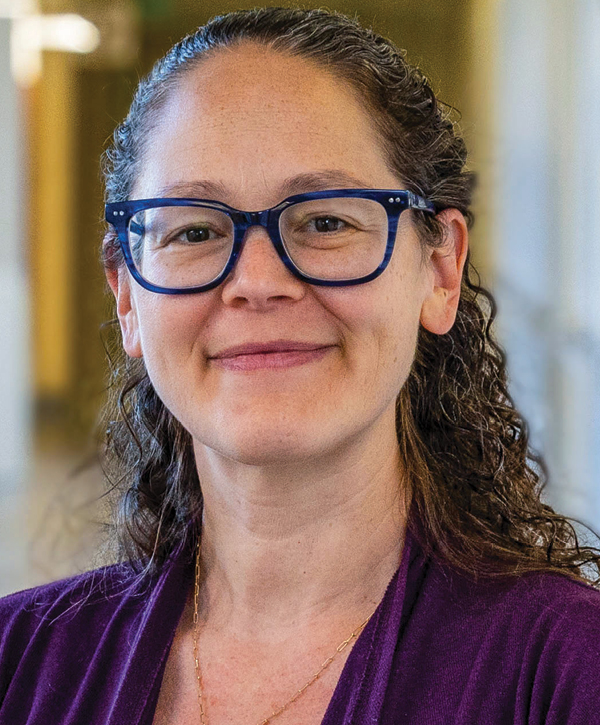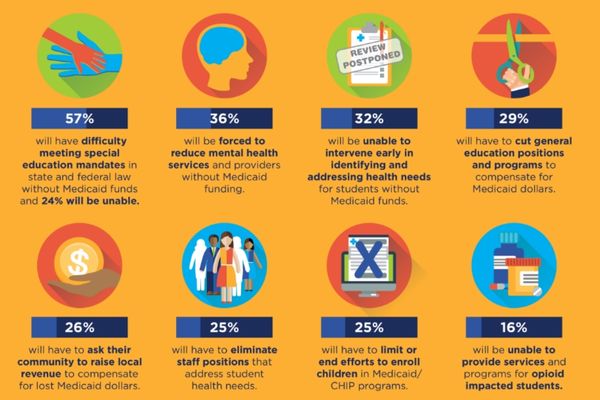Productive Partners: Schools and Health Care Organizations
January 01, 2024
In urban, suburban and rural communities, school-based health centers help students rise above the inequities they face
Factors beyond the classroom affect students’ education outcomes. That is particularly true for those families who have lower incomes, who live in rural areas, or who lack health insurance, suitable housing, transportation or affordable nutritious food.
School-based health centers address these issues by providing access to primary care, behavioral health, and dental and vision care where youth spend most of their time — at school. In collaboration with educators, school staff, families and students, the centers aim to improve educational and health outcomes. The care provided at the centers complements but does not replace or duplicate existing school health services.
Parents or guardians give written consent for their children to receive services, including well-child visits, acute care, asthma and diabetes management, prescriptions and routine lab tests. Many centers also incorporate youth development and offer resources such as food pantries. The goal is to create a culture of health within the school so children can thrive in the classroom and beyond.
This Content is Exclusive to Members
AASA Member? Login to Access the Full Resource
Not a Member? Join Now | Learn More About Membership
Wellness Centers Deliver Even When Schooling Is Remote
By Rebecca Dudovitz, Alex Zepeda and Maryjane Puffer

School-based health centers in Los Angeles are using a collective impact model to support students’ health and well-being alongside academic achievement. The Los Angeles Unified School District established 20 full-scope wellness centers in schools over a 10-year period.
These clinics are sponsored by federally qualified health centers, which also operate community clinics in surrounding neighborhoods and provide comprehensive physical, mental and dental health care, all in one location. The clinics were designed as an access point for students within the campus and for community members. This means students and families can visit the clinics, even when the school is closed. This design allows the clinics to serve as a medical home, which proved extremely valuable during pandemic-related school closures.
A study published in the November 2022 issue of the Journal of School Health found that, even when school campuses were closed to in-person learning, clinic use remained the same. This was especially true for preventive health visits, which is surprising as many families were avoiding other health care sites at the time.
In addition, the study reported, mental health encounters at wellness centers increased for all age groups during the pandemic. This suggests school-based health clinics are meeting a critical need for students and their value extends beyond the convenience of being on a school campus.
A Backbone Group
The collective impact model includes a collaborative network that works together to promote equity through shared learning, alignment and integration of their efforts for population and systems change. The Collective Impact Framework consists of five conditions to be effective: (1) a common agenda; (2) coordination of mutually reinforcing activities; (3) a shared measurement system; (4) continuous communication; and (5) a backbone organization to support these efforts.
The Los Angeles Trust for Children’s Health serves as a backbone organization, bringing clinic and school staff together. Both partners agree to work toward shared outcomes that include both student wellness and academic success. In addition, both entities contribute to a data system, the Data xChange, which links students’ clinic data to academic data from the school district.
Data reports help partners remain accountable to each other and their shared goals and drive quality improvement efforts. These efforts take place three times a year at Learning Collaborative meetings, led by the Los Angeles Trust. Here, clinic and school staff can compare their site’s performance to others and share best practices.
Finally, each has a student advisory board to ensure the clinic is meeting students’ needs. Student advisory boards meet weekly to review their site’s data, plan health and wellness events on their campus and provide feedback to the clinic and school administration about how to deliver teen-friendly services.
The success of the model is supported by a research study in the Journal of Adolescent Health’s September 2023 issue showing that students who visited the wellness centers saw improved attendance over time, especially when visiting for a mental health problem. This is powerful data that shows the importance of investing in student wellness as a key component of a successful school.
Rebecca Dudovitz is a pediatrician and director of pediatric health services research for the Department of Pediatrics at the David Geffen School of Medicine at UCLA in Los Angeles. ALEX ZEPEDA is senior research and data analyst at the Los Angeles Trust for Children’s Health, where MARYJANE PUFFER is executive director.
Federal Laws Govern Privacy at School-Based Health Centers
Student privacy is a concern not just of parents and educators but also of school-based health providers. Ensuring health care privacy encourages young people and their families to seek needed care in a timely manner. Even so, private information sometimes must be shared to avoid harm to the student or others.
Two federal laws determine when and what information can be communicated between school-based health care providers and nurses, counselors, psychiatrists and school staff. Both laws allow information to be shared when a required signed release is in place. Both allow exceptions in some cases for sharing without a release.
The Family Educational Rights and Privacy Act protects individually identifiable information in education records at schools. A student’s health record is part of an education record if an employee of the school, such as a school nurse, created the record. School staff may disclose personal observations not in the education record if it does not violate state laws or professional codes of conduct.
The Health Insurance Portability and Accountability Act’s Privacy Rule limits health care providers from disclosing individually identifiable health information in any form. However, HIPAA’s treatment and emergency exceptions allow a school-based health center physician to share a medication plan with a school nurse or patient information to prevent a threat to the safety of an individual or the public.
In addition, state laws may apply at the same time as HIPPA or FERPA. To learn more about how FERPA, HIPAA, and state laws intersect, visit https://bit.ly/hipaa-ferpa-and-school-health-confidentiality.
Advertisement
Advertisement
Advertisement
Advertisement


.png?sfvrsn=3d584f2d_3)
